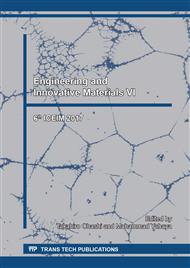p.120
p.127
p.132
p.138
p.147
p.155
p.160
p.167
p.173
Roll Casting of Al-40%Sn-1%Cu Strip
Abstract:
Strip casting of Al-40%Sn-1%Cu, which is an aluminum alloy used for sliding bearings, was attempted using an unequal diameter twin roll caster. The conditions required to cast sound strips, including the roll speed, molten temperature, roll load, solidification length, melt head, and use of an upper plate, were investigated. The roll load required to make a stable strip surface was 0.01 kN/mm, and the porosity was minimum when the solidification time was less than 0.6 s. The solidification time was controlled by the roll speed and the solidification length. The casting temperature must be set below 670°C to properly solidify the molten metal, and the metal microstructure became finer as the melt head decreased.
Info:
Periodical:
Pages:
147-154
Citation:
Online since:
January 2018
Authors:
Price:
Сopyright:
© 2018 Trans Tech Publications Ltd. All Rights Reserved
Share:
Citation:


